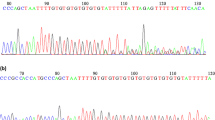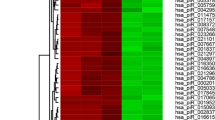Abstract
Purpose
Azoospermia is one of the major causes of male infertility and is basically classified into obstructive (OA) and non-obstructive azoospermia (NOA). The molecular background of NOA still largely remains elusive. It has been shown that the poly(A)-binding proteins (PABPs) essentially play critical roles in stabilization and translational control of the mRNAs during spermatogenesis.
Methods
In the present study, we aim to evaluate expression levels of the PABP genes, EPAB, PABPC1, and PABPC3, in the testicular biopsy samples and in the isolated spermatocyte (SC) and round spermatid (RS) fractions obtained from men with various types of NOA including hypospermatogenesis (hyposperm), RS arrest, SC arrest, and Sertoli cell-only syndrome (SCO).
Results
In the testicular biopsy samples, both PABPC1 and PABPC3 mRNA expressions were gradually decreased from hyposperm to SCO groups (P < 0.05), whereas there was no remarkable difference for the EPAB expression among groups. The expression levels of cytoplasmically localized PABPC1 and PABPC3 proteins dramatically reduced from hyposperm to SCO groups (P < 0.05). In the isolated SC and RS fractions, the EPAB, PABPC1, and PABPC3 mRNA expressions were gradually decreased from hyposperm to SC arrest groups (P < 0.05). Similarly, both PABPC1 and PABPC3 proteins were expressed at higher levels in the SC and RS fractions from hyposperm group when compared to the SC and RS fractions from either RS arrest or SC arrest group (P < 0.05).
Conclusion
Our findings suggest that observed significant alterations in the PABPs expression may have an implication for development of different NOA forms.






Similar content being viewed by others
References
Dube E, Hermo L, Chan PT, Cyr DG. Alterations in gene expression in the caput epididymides of nonobstructive azoospermic men. Biol Reprod. 2008;78:342–51.
Gnoth C, Godehardt E, Frank-Herrmann P, Friol K, Tigges J, Freundl G. Definition and prevalence of subfertility and infertility. Hum Reprod. 2005;20:1144–7.
Hamada A, Esteves SC, Nizza M, Agarwal A. Unexplained male infertility: diagnosis and management. Int Braz J Urol. 2012;38:576–94.
Wosnitzer M, Goldstein M, Hardy MP. Review of azoospermia. Spermatogenesis. 2014;4:e28218.
Hargreave TB. Genetic basis of male fertility. Br Med Bull. 2000;56:650–71.
Safran A, Reubinoff BE, Porat-Katz A, Schenker JG Lewin A. Assisted reproduction for the treatment of azoospermia. Hum Reprod. 1998;13 Suppl 4:47–60.
Malcher A, Rozwadowska N, Stokowy T, Kolanowski T, Jedrzejczak P, Zietkowiak W, et al. Potential biomarkers of nonobstructive azoospermia identified in microarray gene expression analysis. Fertil Steril. 2013;100:1686–94e1–7.
Lin YH, Lin YM, Teng YN, Hsieh TY, Lin YS Kuo PL. Identification of ten novel genes involved in human spermatogenesis by microarray analysis of testicular tissue. Fertil Steril. 2006;86:1650–8.
Fox MS, Ares VX, Turek PJ, Haqq C, Reijo Pera RA. Feasibility of global gene expression analysis in testicular biopsies from infertile men. Mol Reprod Dev. 2003;66:403–21.
Nayernia K, Adham I, Kremling H, Reim K, Schlicker M, Schluter G, et al. Stage and developmental specific gene expression during mammalian spermatogenesis. Int J Dev Biol. 1996;40:379–83.
Holstein AF, Schulze W, Davidoff M. Understanding spermatogenesis is a prerequisite for treatment. Reprod Biol Endocrinol. 2003;1:107.
Hecht NB. Molecular mechanisms of male germ cell differentiation. Bioessays. 1998;20:555–61.
Steger K. Transcriptional and translational regulation of gene expression in haploid spermatids. Anat Embryol. 1999;199:471–87.
Kleene KC. Poly(A) shortening accompanies the activation of translation of five mRNAs during spermiogenesis in the mouse. Development. 1989;106:367–73.
Elliott D. Pathways of post-transcriptional gene regulation in mammalian germ cell development. Cytogenet Genome Res. 2003;103:210–6.
Kleene KC, Distel RJ, Hecht NB. Translational regulation and deadenylation of a protamine mRNA during spermiogenesis in the mouse. Dev Biol. 1984;105:71–9.
Wilkie GS, Gautier P, Lawson D, Gray NK. Embryonic poly(A)-binding protein stimulates translation in germ cells. Mol Cell Biol. 2005;25:2060–71.
Voeltz GK, Ongkasuwan J, Standart N, Steitz JA. A novel embryonic poly(A) binding protein, ePAB, regulates mRNA deadenylation in Xenopus egg extracts. Genes Dev. 2001;15:774–88.
Friend K, Brook M, Bezirci FB, Sheets MD, Gray NK, Seli E. Embryonic poly(A)-binding protein (ePAB) phosphorylation is required for Xenopus oocyte maturation. Biochem J. 2012;445:93–100.
Gorgoni B, Richardson WA, Burgess HM, Anderson RC, Wilkie GS, Gautier P, et al. Poly(A)-binding proteins are functionally distinct and have essential roles during vertebrate development. Proc Natl Acad Sci U S A. 2011;108:7844–9.
Kimura M, Ishida K, Kashiwabara S, Baba T. Characterization of two cytoplasmic poly(A)-binding proteins, PABPC1 and PABPC2, in mouse spermatogenic cells. Biol Reprod. 2009;80:545–54.
Kleene KC, Wang MY, Cutler M, Hall C, Shih D. Developmental expression of poly(A) binding protein mRNAs during spermatogenesis in the mouse. Mol Reprod Dev. 1994;39:355–64.
Wormington M, Searfoss AM, Hurney CA. Overexpression of poly(A) binding protein prevents maturation-specific deadenylation and translational inactivation in Xenopus oocytes. EMBO J. 1996;15:900–9.
Feral C, Guellaen G, Pawlak A. Human testis expresses a specific poly(A)-binding protein. Nucleic Acids Res. 2001;29:1872–83.
Seli E, Lalioti MD, Flaherty SM, Sakkas D, Terzi N, Steitz JA. An embryonic poly(A)-binding protein (ePAB) is expressed in mouse oocytes and early preimplantation embryos. Proc Natl Acad Sci U S A. 2005;102:367–72.
Ozturk S, Guzeloglu-Kayisli O, Demir N, Sozen B, Ilbay O, Lalioti MD, et al. Epab and Pabpc1 are differentially expressed during male germ cell development. Reprod Sci. 2012;19:911–22.
Guzeloglu-Kayisli O, Pauli S, Demir H, Lalioti MD, Sakkas D, Seli E. Identification and characterization of human embryonic poly(A) binding protein (EPAB). Mol Hum Reprod. 2008;14:581–8.
Ozturk S, Guzeloglu-Kayisli O, Lowther KM, Lalioti MD, Sakkas D, Seli E. Epab is dispensable for mouse spermatogenesis and male fertility. Mol Reprod Dev. 2014;81:390.
Guzeloglu-Kayisli O, Lalioti MD, Aydiner F, Sasson I, Ilbay O, Sakkas D, et al. Embryonic poly(A)-binding protein (EPAB) is required for oocyte maturation and female fertility in mice. Biochem J. 2012;446:47–58.
Guzeloglu-Kayisli O, Lalioti MD, Babayev E, Torrealday S, Karakaya C, Seli E. Human embryonic poly(A)-binding protein (EPAB) alternative splicing is differentially regulated in human oocytes and embryos. Mol Hum Reprod. 2013;20:59–65.
WHO. Laboratory manual for the examination of human semen and sperm-cervical mucus interaction 1999.
Ozturk S, Sozen B Demir N. Epab and Pabpc1 are differentially expressed in the postnatal mouse ovaries JARG. 2014.
Chatterjee S, Malhotra R, Varghese F, Bukhari AB, Patil A, Budrukkar A, et al. Quantitative immunohistochemical analysis reveals association between sodium iodide symporter and estrogen receptor expression in breast cancer. PLoS One. 2013;8:e54055.
Ozturk S, Yaba-Ucar A, Sozen B, Mutlu D, Demir N. Superovulation alters embryonic poly(A)-binding protein (epab) and poly(A)-binding protein, cytoplasmic 1 (Pabpc1) gene expression in mouse oocytes and early embryos. Reprod Fertil Dev. 2014. doi:10.1071/RD14106.
Kotaja N, Kimmins S, Brancorsini S, Hentsch D, Vonesch JL, Davidson I, et al. Preparation, isolation and characterization of stage-specific spermatogenic cells for cellular and molecular analysis. Nat Methods. 2004;1:249–54.
Bellve AR. Purification, culture, and fractionation of spermatogenic cells. Methods Enzymol. 1993;225:84–113.
Romrell LJ, Bellve AR, Fawcett DW. Separation of mouse spermatogenic cells by sedimentation velocity. A morphological characterization. Dev Biol. 1976;49:119–31.
Vasco C, Zuccotti M, Redi CA, Garagna S. Identification, isolation, and RT-PCR analysis of single stage-specific spermatogenetic cells obtained from portions of seminiferous tubules classified by transillumination microscopy. Mol Reprod Dev. 2009;76:1173–7.
Rockett JC, Patrizio P, Schmid JE, Hecht NB, Dix DJ. Gene expression patterns associated with infertility in humans and rodent models. Mutat Res. 2004;549:225–40.
Ghalayini IF, Al-Ghazo MA, Hani OB, Al-Azab R, Bani-Hani I, Zayed F, et al. Clinical comparison of conventional testicular sperm extraction and microdissection techniques for non-obstructive azoospermia. J Clin Med Res. 2011;3:124–31.
Turek PJ, Ljung BM, Cha I, Conaghan J. Diagnostic findings from testis fine needle aspiration mapping in obstructed and nonobstructed azoospermic men. J Urol. 2000;163:1709–16.
Acknowledgments
The authors thank Deniz Ozel-Erkan, M.Sc. for her contribution to statistical analysis of data, and thank Asli Uyar, Ph.D. for critically reading the article.
Authors’ roles
S.O. and N.D. designed the study. S.O., B.S., and F.U. created all data, and S.O. wrote the article. I.C.B. performed pathological analysis of the testicular biopsies. M.F.U. provided the testicular biopsy samples. N.D. and G.A. critically read the article.
Author information
Authors and Affiliations
Corresponding author
Ethics declarations
Funding
This study was supported by TUBITAK (Grant No. 112S169).
Conflict of interest
The authors declare that there is no conflict of interest.
Additional information
Capsule The EPAB, PABPC1 and PABPC3 proteins seem to be important RNA-binding proteins in regulating translation control of the mRNAs in spermatogenic cells during spermatogenesis.
Electronic supplementary material
Below is the link to the electronic supplementary material.
Supplementary Fig. 1
Representative image of hematoxylin and eosin (HE)-stained sections of the NOA groups. The HE-stained sections of each group were analyzed under a bright-field microscopy, and thereby their histopathological characteristics and Johnsen scores were determined. Classification of the testicular biopsy samples into different non-obstructive azoospermia (NOA) groups were performed based on their spermatogenic activity and germinal epithelial cell content, and they were accordingly separated into groups as follows: a hypospermatogenesis, b round spermatid arrest, c spermatocyte arrest, and d Sertoli cell-only syndrome. SG spermatogonia, SC spermatocyte, RS round spermatid, ES elongated spermatid, SE Sertoli cell, IT intertubular area, L lumen. Scale bar: 50 μm. (JPG 1.39 MB)
Supplementary Fig. 2
Localization of the EPAB transcript in the human testis tissue. We have detected EPAB mRNA localization in the testicular biopsy samples obtained from men with hyposperm. For this purpose, EPAB probe specific to exons 1 and 2 was produced as the following processes: RNA isolation, cDNA synthesis, and PCR amplification. a A representative photomicrograph of the RNA in situ hybridization on the testis section from hyposperm group. We observed that EPAB mRNA was cytoplasmically expressed in the spermatogenic cells as well as in the intertubular somatic cells. b A representative photomicrograph of the negative control section. As expected, there was no reaction for the EPAB unlabeled probe in the negative control section. SG spermatogonia, SC spermatocyte, RS round spermatid, ES elongated spermatid, SE Sertoli cell, IT intertubular area, L lumen. Scale bar: 50 μm. (JPG 1.49 MB)
Supplementary Fig. 3
Particular features of the isolated SC and RS fractions from hyposperm, RS arrest, and SC arrest groups using 2–4 % bovine serum albumin (BSA) gradient. Representative photomicrographs of the SC (a) and RS (b) fractions were captured by an inverted microscopy (Olymus) at original magnification of ×400. Scale bar: 50 μm. To determine purity percent of the isolated spermatocyte and round spermatid fractions, their smear slides were air-dried, and then stained with hematoxylin-eosin. Representative photomicrographs of hematoxylin-eosin-stained SC (c) and RS (d) fractions were taken at original magnification of ×200; inserts were at ×1000 magnification. Scale bar: 50 μm. e The HE-stained slides were examined with the bright-field microscope (Zeiss) to determine purity percent of the isolated SC and RS fractions, which were identified based on their morphological characteristics. In general, the purity rates of isolated spermatocyte and round spermatid fractions were in usable levels (>77 %); however, the RS fraction obtained from RS arrest group was found to be in low levels (∼24 %). SG spermatogonia, SC spermatocyte, RS round spermatid, SE Sertoli cell, OC other cell, Hyposperm hypospermatogenesis, RS arrest round spermatid arrest, SC arrest spermatocyte arrest. Data are presented as mean ± standard deviation (SD). (JPG 1.76 MB)
Supplementary Table 1
Sequences and localizations of primers for EPAB, PABPC1, and PABPC3 genes used in the current study. F, Forward; R, Reverse; bp, base pair. (JPG 690 KB)
Supplementary Table 2
Histopathologic features of the testicular biopsy samples obtained from various types of NOA groups. J.S., Johnsen score. (JPG 2.30 MB)
Rights and permissions
About this article
Cite this article
Ozturk, S., Sozen, B., Uysal, F. et al. The poly(A)-binding protein genes, EPAB, PABPC1, and PABPC3 are differentially expressed in infertile men with non-obstructive azoospermia. J Assist Reprod Genet 33, 335–348 (2016). https://doi.org/10.1007/s10815-016-0654-z
Received:
Accepted:
Published:
Issue Date:
DOI: https://doi.org/10.1007/s10815-016-0654-z




